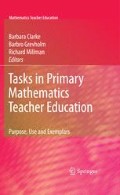While there is a large body of research on mathematical problem solving and modelling at primary school level, the mathematical modelling process itself has not been given much attention in research. In order to support and identify mathematical modelling processes, Fermi problems have been used in a classroom based study with third and fourth graders. In contrast to standard word problems that frequently just require the application of one or two simple algorithms and therefore do not provide information on how to find a mathematical model, Fermi problems provide the necessary complexity for studying authentic mathematical modelling. Videotapes of small group work in a grade four classroom provided the data basis. The analysis of the classroom data suggests that word problems with a high level of complexity can be solved in sensible and appropriate ways by third and fourth graders. The Fermi problems in this context served as “model-eliciting tasks”, because the required modelling process necessitates multiple modelling cycles with multiple ways of thinking about givens, goals, and solution paths.
Access this chapter
Tax calculation will be finalised at checkout
Purchases are for personal use only
Preview
Unable to display preview. Download preview PDF.
References
Bauersfeld, H. (1991). Sachaufgaben! — Nichts als Ä rger!? Grundschulzeitschrift, 42, 8–10.
Bauersfeld, H., Krummheuer, G.,&Voigt, J. (1988). Interactional theory of learning and teaching mathematics and related mircroethnographical studies. In H.-G. Steiner&A. Vermandel (Eds.), Foundations and methodology of the discipline mathematics education (pp. 174–188). Bielefeld: Bielefeld University, IDM.
Bell, M. (1993). Modelling and applications of mathematics in the primary curriculum. In T. Breiteig, I. Huntley,&G. Kaiser-Messmer (Eds.), Teaching and learning mathematics in context (pp. 71–80). London: Ellis Horwood.
Clarke, D. J.,&McDonough, A. (1989). The problems of the problem-solving classroom. The Australian Mathematics Teacher, 45(2), 20–24.
de Lange, J. (1998). Real problems with real world mathematics. In C. Alsina, J. Alvarez, M. Niss, A. Pérez, L. Rico,&A. Sfard (Eds.), Proceedings of the 8th International Congress on Mathematical Education (pp. 83–110). Seville: SAEM Thales.
Freudenthal, H. (1984). Wie alt ist der Kapitän? Mathematik lehren, 5, 38–39.
Heymann, H. W. (2003). Why teach mathematics? A focus on general education. Dordrecht: Kluwer.
Lesh, R.,&Doerr, H. (2000). Symbolizing, communicating and mathematizing: Key components of models and modelling. In P. Cobb, E. Yackel,&K. McClain (Eds.), Symbolizing and communicating in mathematics classrooms (pp. 361–383). Mahwah, NJ: Erlbaum.
Pehkonen, E. (1991). Developments in the understanding of problem solving. Zentralblatt für Mathematikdidaktik, 23(2), 46–50.
Peschel, F. (1996). Offener Unterricht am Ende — oder erst am Anfang? Projekt OASE Bericht No. 2, FB2 der Universität Gesamthochschule Siegen.
Peter-Koop, A. (2001). From “teachers researchers” to “student teacher researchers”: Diagnosti-cally enriched didactics. In M. van den Heuvel-Panhuizen (Ed.), Proceedings of the 25th conference of the International Group for the Psychology of Mathematics Education (Vol. 1, pp. 72–79). Utrecht University.
Peter-Koop, A. (2002). Real-world problem solving in small groups: Interaction patterns of third and fourth graders. In B. Barton, C. Irwin, M. Pfannkuch,&M. O. J. Thomas (Eds.), Mathematics education in the south pacific (Proceedings of the 25th annual conference of the Mathematics Education Research Group of Australasia, Auckland, pp. 559–566). Sydney: MERGA.
Peter-Koop, A.,&Wollring, B. (2001). Student teacher participation in interpretative classroom research projects. Mathematics Teacher Education and Development, 3, 4–15.
Pólya, G. (1957). How to solve it. A new aspect of mathematical method. Princeton, NJ: Princeton University Press.
Reed, S. K. (1999). Word problems. Research and curriculum reform. Mahwah, NJ: Erlbaum.
Renkl, A.,&Stern, E. (1994). Die Bedeutung von kognitiven Eingangsvoraussetzungen und schulischen Lerngelegenheiten für das Lösen von einfachen und komplexen Textaufgaben. Zeitschrift für Pädagogische Psychologie, 8(1), 27–39.
Silver, E. A. (1995). The nature and use of open problems in mathematics education: Mathematical and pedagogical perspectives. Zentralblatt für Didaktik der Mathematik, 27(2), 67–72.
van den Heuvel-Panhuizen, M. (1996). Assessment and realistic mathematics education. Utrecht: CD-B Press, Utrecht University.
Verschaffel, L.,&De Corte, E. (1997). Teaching realistic mathematical modelling and problem solving in the elementary school. A teaching experiment with fifth graders. Journal for Research in Mathematics Education, 28(5), 577–601.
Verschaffel, L., De Corte, E.,&Lasure, S. (1994). Realistic considerations in mathematical modelling of school arithmetic word problems. Learning and Instruction, 4, 273–294.
Verschaffel, L., De Corte, E.,&Lasure, S. (1999). Children's conceptions about the role of real-world knowledge in mathematical modelling of school word problems. In W. Schnotz, S. Vosniadou, M. Carretero (Eds.), New perspectives on conceptual change (pp. 175–189). Oxford, UK: Elsevier Science.
Verschaffel, L., Greer, B., and de Corte, E. (2000). Making sense of word problems. Lisse: Svets Zeitlinger.
Winter, H. (1994). Modelle als Konstrukte zwischen lebensweltlichen Situationen und arithmetis-chen Begriffen. Grundschule, 26(3), 10–13.
Author information
Authors and Affiliations
Editor information
Editors and Affiliations
Rights and permissions
Copyright information
© 2009 Springer Science+Business Media, LLC
About this chapter
Cite this chapter
Peter-Koop, A. (2009). Teaching and Understanding Mathematical Modelling through Fermi-Problems. In: Clarke, B., Grevholm, B., Millman, R. (eds) Tasks in Primary Mathematics Teacher Education. Mathematics Teacher Education, vol 4. Springer, Boston, MA. https://doi.org/10.1007/978-0-387-09669-8_10
Download citation
DOI: https://doi.org/10.1007/978-0-387-09669-8_10
Publisher Name: Springer, Boston, MA
Print ISBN: 978-0-387-09668-1
Online ISBN: 978-0-387-09669-8
eBook Packages: Humanities, Social Sciences and LawEducation (R0)

